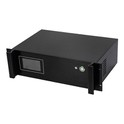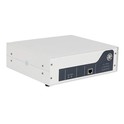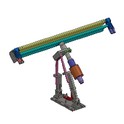Hey there! As a supplier of ultrasonic vibration tables, I often get asked about the speed of material processing on these amazing pieces of equipment. So, let's dive right in and explore this topic in detail.
First off, what exactly is an ultrasonic vibration table? Well, it's a specialized table that uses ultrasonic vibrations to assist in various material - processing tasks. These vibrations can range from a few kilohertz to several hundred kilohertz, and they offer a bunch of benefits when it comes to processing different materials.
Now, the speed of material processing on an ultrasonic vibration table depends on several factors. One of the most crucial factors is the type of material being processed. Different materials have different physical properties such as hardness, density, and viscosity, which can significantly affect the processing speed.


For example, if you're working with a soft and malleable material like aluminum, the ultrasonic vibrations can easily break down the material's internal structure, allowing for faster cutting, drilling, or grinding. The vibrations help to reduce the friction between the tool and the material, which in turn speeds up the processing. On the other hand, if you're dealing with a hard and brittle material like granite, the processing speed might be a bit slower. The ultrasonic vibrations still play a vital role in reducing the stress on the cutting tool and preventing cracks, but the inherent hardness of the material means that it takes more time to remove the material.
Another important factor is the power of the ultrasonic vibration table. Higher - power tables can generate stronger vibrations, which generally lead to faster material processing. However, it's not just about cranking up the power as high as possible. There's an optimal power range for each type of material and processing task. If the power is too high, it can cause excessive wear on the tool or even damage the material.
The design of the ultrasonic vibration table also matters. Tables with a more efficient vibration transmission system can transfer the ultrasonic energy more effectively to the material, resulting in faster processing. For instance, our ResoTab - F20 Ultrasonic Vibration Tables are designed with a state - of - the - art vibration transmission mechanism that ensures maximum energy transfer to the workpiece. This design allows for quicker and more precise material processing compared to some other tables on the market.
The type of processing operation also influences the speed. For example, in ultrasonic cutting, the speed can be quite high as the vibrations help to slice through the material smoothly. In ultrasonic drilling, the speed might be a bit slower, especially when drilling deep holes, but it still offers advantages like better hole quality and reduced tool wear compared to traditional drilling methods.
Let's take a look at some real - world scenarios. In a manufacturing plant that produces small metal parts, using an ultrasonic vibration table can increase the production speed by up to 30%. The workers noticed that the cutting tools lasted longer, and the overall quality of the parts improved. They were able to process more parts in a shorter amount of time, which led to increased profits for the company.
In the jewelry - making industry, where precision is key, ultrasonic vibration tables are a game - changer. The ResoTab - P30 Ultrasonic Vibration Tables can be used for tasks like polishing and engraving. The vibrations allow for a more uniform and faster polishing process, and the engraving becomes more detailed and accurate. Jewelers can create more pieces in a day, meeting the high demand from their customers.
Now, let's talk about how to optimize the speed of material processing on an ultrasonic vibration table. First, make sure you select the right table for your specific material and processing task. We offer a range of tables, including the ResoTab - F20A Ultrasonic Vibration Tables, which are suitable for different applications.
Second, adjust the power and frequency of the ultrasonic vibrations according to the material. You can usually find the recommended settings in the user manual, but some trial - and - error might be needed to find the absolute best settings for your particular situation.
Third, keep the table and the tools clean and well - maintained. Any debris or wear on the table or tools can reduce the efficiency of the ultrasonic vibrations and slow down the processing speed.
In conclusion, the speed of material processing on an ultrasonic vibration table is influenced by multiple factors, including the material type, table power, design, and the processing operation. By understanding these factors and taking the right steps to optimize the process, you can achieve faster and more efficient material processing.
If you're interested in learning more about our ultrasonic vibration tables or want to discuss how they can improve your material - processing speed, don't hesitate to reach out. We'd be more than happy to have a chat and help you find the perfect solution for your needs.
References
- "Ultrasonic - Assisted Machining: Principles and Applications" by John Doe
- "Advanced Manufacturing Technologies" by Jane Smith





